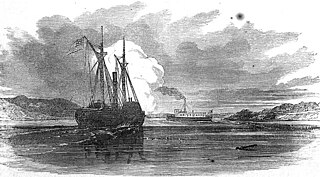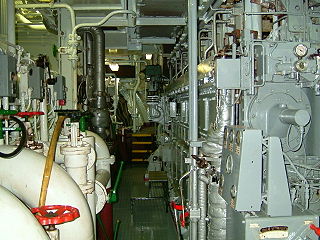
A hull is the watertight body of a ship, boat, or flying boat. The hull may open at the top, or it may be fully or partially covered with a deck. Atop the deck may be a deckhouse and other superstructures, such as a funnel, derrick, or mast. The line where the hull meets the water surface is called the waterline.

A propeller is a device with a rotating hub and radiating blades that are set at a pitch to form a helical spiral which, when rotated, exerts linear thrust upon a working fluid such as water or air. Propellers are used to pump fluid through a pipe or duct, or to create thrust to propel a boat through water or an aircraft through air. The blades are shaped so that their rotational motion through the fluid causes a pressure difference between the two surfaces of the blade by Bernoulli's principle which exerts force on the fluid. Most marine propellers are screw propellers with helical blades rotating on a propeller shaft with an approximately horizontal axis.

Naval architecture, or naval engineering, is an engineering discipline incorporating elements of mechanical, electrical, electronic, software and safety engineering as applied to the engineering design process, shipbuilding, maintenance, and operation of marine vessels and structures. Naval architecture involves basic and applied research, design, development, design evaluation (classification) and calculations during all stages of the life of a marine vehicle. Preliminary design of the vessel, its detailed design, construction, trials, operation and maintenance, launching and dry-docking are the main activities involved. Ship design calculations are also required for ships being modified. Naval architecture also involves formulation of safety regulations and damage-control rules and the approval and certification of ship designs to meet statutory and non-statutory requirements.

A jetboat is a boat propelled by a jet of water ejected from the back of the craft. Unlike a powerboat or motorboat that uses an external propeller in the water below or behind the boat, a jetboat draws the water from under the boat through an intake and into a pump-jet inside the boat, before expelling it through a nozzle at the stern.

A tugboat or tug is a marine vessel that manoeuvres other vessels by pushing or pulling them, with direct contact or a tow line. These boats typically tug ships in circumstances where they cannot or should not move under their own power, such as in crowded harbors or narrow canals, or cannot move at all, such as barges, disabled ships, log rafts, or oil platforms. Some are ocean-going, and some are icebreakers or salvage tugs. Early models were powered by steam engines, which were later superseded by diesel engines. Many have deluge gun water jets, which help in firefighting, especially in harbours.

A rudder is a primary control surface used to steer a ship, boat, submarine, hovercraft, airship, or other vehicle that moves through a fluid medium. On an airplane, the rudder is used primarily to counter adverse yaw and p-factor and is not the primary control used to turn the airplane. A rudder operates by redirecting the fluid past the hull or fuselage, thus imparting a turning or yawing motion to the craft. In basic form, a rudder is a flat plane or sheet of material attached with hinges to the craft's stern, tail, or after end. Often rudders are shaped so as to minimize hydrodynamic or aerodynamic drag. On simple watercraft, a tiller—essentially, a stick or pole acting as a lever arm—may be attached to the top of the rudder to allow it to be turned by a helmsman. In larger vessels, cables, pushrods, or hydraulics may be used to link rudders to steering wheels. In typical aircraft, the rudder is operated by pedals via mechanical linkages or hydraulics.

An icebreaker is a special-purpose ship or boat designed to move and navigate through ice-covered waters, and provide safe waterways for other boats and ships. Although the term usually refers to ice-breaking ships, it may also refer to smaller vessels, such as the icebreaking boats that were once used on the canals of the United Kingdom.

Boat building is the design and construction of boats and their systems. This includes at a minimum a hull, with propulsion, mechanical, navigation, safety and other systems as a craft requires.

A pump-jet, hydrojet, or water jet is a marine system that produces a jet of water for propulsion. The mechanical arrangement may be a ducted propeller, a centrifugal pump, or a mixed flow pump which is a combination of both centrifugal and axial designs. The design also incorporates an intake to provide water to the pump and a nozzle to direct the flow of water out of the pump.

On a ship, the engine room (ER) is the compartment where the machinery for marine propulsion is located. The engine room is generally the largest physical compartment of the machinery space. It houses the vessel's prime mover, usually some variations of a heat engine. On some ships, there may be more than one engine room, such as forward and aft, or port or starboard engine rooms, or may be simply numbered. To increase a vessel's safety and chances of surviving damage, the machinery necessary for the ship's operation may be segregated into various spaces.
This glossary of nautical terms is an alphabetical listing of terms and expressions connected with ships, shipping, seamanship and navigation on water. Some remain current, while many date from the 17th to 19th centuries. The word nautical derives from the Latin nauticus, from Greek nautikos, from nautēs: "sailor", from naus: "ship".

Astern propulsion is a maneuver in which a ship's propelling mechanism is used to develop thrust in a retrograde direction. Astern propulsion does not necessarily imply the ship is moving astern ; astern propulsion is used to slow a ship by applying a force in the direction of the bow of the ship, instead of the stern. The equivalent concept for an airplane is thrust reversal.

The Kitchen rudder is the familiar name for "Kitchen's Patent Reversing Rudders", a combination rudder and directional propulsion delivery system for relatively slow speed displacement boats which was invented in the early 20th century by John G. A. Kitchen of Lancashire, England. It turns the rudder into a directional thruster, and allows the engine to maintain constant revolutions and direction of drive shaft rotation while altering thrust by use of a control which directs thrust forward or aft. Only the rudder pivots; the propeller itself is on a fixed shaft and does not.
A teardrop hull is a submarine hull design which emphasizes submerged performance over surfaced performance. It was somewhat commonly used in the early stages of submarine development, but was gradually abandoned in the early 20th century in favour of designs optimized for high performance on the surface as a result of changes in operational doctrine. Although naval doctrine changed, design practices remained until the later parts of World War II when the German Kriegsmarine suffered ever-growing losses of submarines in the Battle of the Atlantic.

The draft or draught of a ship's hull is the vertical distance between the waterline and the bottom of the hull (keel). The draught of the vessel is the maximum depth of any part of the vessel, including appendages such as rudders, propellers and drop keels if deployed. Draft determines the minimum depth of water a ship or boat can safely navigate. The related term air draft is the maximum height of any part of the vessel above the water.
Internal drive propulsion or water-jet propulsion is a form of marine propulsion used in recreational boating. Like other forms of motorized boating, internal drive propulsion employs a motor that turns a propeller to move the boat forward. The primary difference between internal drive boats and external drive boats is that the propeller is enclosed inside the hull of an internal drive boat whereas the propeller is exposed outside the hull of a stern drive, V-drive or straight shaft drive boat.

In some boats and ships, a transom is the aft transverse surface of the hull that forms the stern of a vessel. Historically, they are a development from the canoe stern wherein which both bow and stern are pointed.
Schottel is a manufacturer of propulsion and steering systems for ships and offshore applications. The company founder Josef Becker invented the rudderpropeller, a z-drive, in 1950. Today the company develops and manufactures azimuth propulsion, maneuvering and steering systems. In 2014 the subsidiary Schottel Hydro was founded to bundle up the company activities in the hydrokinetic energy segment.

A marine thruster is a device for producing directed hydrodynamic thrust mounted on a marine vehicle, primarily for maneuvering or propulsion. There are a variety of different types of marine thrusters and each of them plays a role in the maritime industry. Marine thrusters come in many different shapes and sizes, for example screw propellers, Voith-Schneider propellers, waterjets, ducted propellers, tunnel bow thrusters, and stern thrusters, azimuth thrusters, rim-driven thrusters, ROV and submersible drive units. A marine thruster consists of a propeller or impeller which may be encased in some kind of tunnel or ducting that directs the flow of water to produce a resultant force intended to obtain movement in the desired direction or resist forces which would cause unwanted movement. The two subcategories of marine thrusters are for propulsion and maneuvering, the maneuvering thruster typically in the form of bow or stern thrusters and propulsion thrusters ranging from Azimuth thrusters to Rim Drive thrusters.
This glossary of nautical terms is an alphabetical listing of terms and expressions connected with ships, shipping, seamanship and navigation on water. Some remain current, while many date from the 17th to 19th centuries. The word nautical derives from the Latin nauticus, from Greek nautikos, from nautēs: "sailor", from naus: "ship".

















